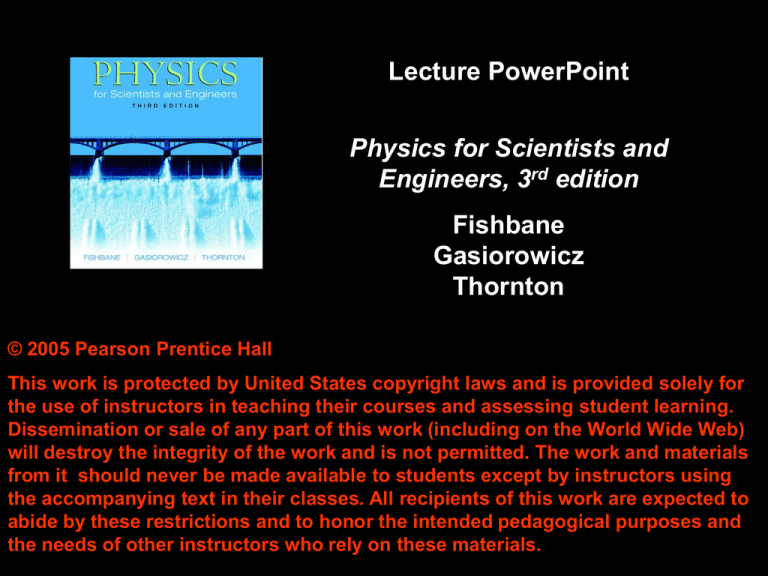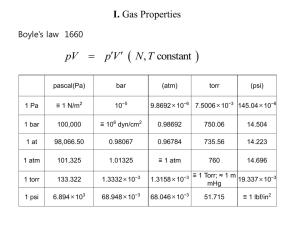
Lecture PowerPoint
Physics for Scientists and
Engineers, 3rd edition
Fishbane
Gasiorowicz
Thornton
© 2005 Pearson Prentice Hall
This work is protected by United States copyright laws and is provided solely for
the use of instructors in teaching their courses and assessing student learning.
Dissemination or sale of any part of this work (including on the World Wide Web)
will destroy the integrity of the work and is not permitted. The work and materials
from it should never be made available to students except by instructors using
the accompanying text in their classes. All recipients of this work are expected to
abide by these restrictions and to honor the intended pedagogical purposes and
the needs of other instructors who rely on these materials.
Chapter 19
The Molecular Basis of
Thermal Physics
Main Points of Chapter 19
• Microscopic view of gases
• Pressure
• Temperature
• Probability distributions
• Maxwell-Boltzmann velocity distribution
• Collisions and transport
19-1 A Microscopic View of Gases
Knowing:
• The mass and volume of a certain amount
of air at room temperature and pressure
• The mass of a typical air molecule
• The size of a typical air molecule
We can calculate the average separation
between molecules:
• On average, molecules are separated by
about 20 times their radii
19-1 A Microscopic View of Gases
A balloon-sized volume of air contains about 1023
molecules – even though individual molecular
actions are random, we can understand air very
well through its bulk properties.
19-2 Pressure and Molecular Motion
Have box containing dilute gas, volume V,
temperature T.
Average velocity in any direction is zero – there is
no net movement of the gas:
(19-1)
The brackets are used to indicate average value.
19-2 Pressure and Molecular Motion
Average speed is not zero, though; we take the square of
the speeds (which is positive), average it, and then take the
square root. This is the rms (root mean square) value, and
is never negative:
19-2 Pressure and Molecular Motion
Internal energy U comes mostly from the kinetic
energies of the molecules:
(19-2)
The average squares of velocities in all three
directions are the same:
(19-5)
19-2 Pressure and Molecular Motion
Now, relate
to the pressure of the gas:
Pressure comes from the collisions of
molecules with the walls of the container.
If we look at a wall in the y-z plane, only the xcomponent of the molecules’ momentum
transfers momentum to it:
(19-6)
Next: look at the number of collisions per unit
time.
19-2 Pressure and Molecular Motion
Take imaginary cylindrical volume that abuts the
wall.
Left: the volume
Right: the x-components are the only ones that
matter here
19-2 Pressure and Molecular Motion
If the number density of molecules (same in
the cylinder as in the rest of the gas) is N/V,
then the number of collisions in time dt is:
(19-7)
And the momentum transfer is:
19-2 Pressure and Molecular Motion
The force is the momentum transfer per unit time:
(19-8)
and the pressure is the force per unit area:
(19-9)
19-2 Pressure and Molecular Motion
Finally, using the rms value of the velocity”
(19-10)
(19-11)
This is important!
Microscopic properties have been used to find a
relation between macroscopic thermodynamic
variables.
19-3 The Meaning of Temperature
Since internal energy is related to pressure
and volume, it is also related to temperature:
(19-12)
and to the average kinetic energy of the molecules:
(19-13)
19-3 The Meaning of Temperature
We can also understand the van der Waals
equation better now.
It includes the effects of intermolecular
forces, which act over distances larger than
the size of the molecule, are repulsive at
short range, and slightly attractive at longer
distances.
(17-15)
19-4 Probability Distributions
Not all molecules have the average velocity,
of course; for a more complete description
we need a velocity distribution function,
which tells us how many molecules have
any particular velocity.
The position distribution function does the
same thing for the molecules’ location in
space.
19-4 Probability Distributions
There are enough molecules in a macroscopic gas
sample that the distributions can be considered to
be continuous. We define the probability that a
value lies within an interval Δx around a value x:
The probabilities are
normalized so that the
total value is one – x
must be something.
(19-22)
19-5 The Velocity Distribution of Gases
First, define a velocity probability function:
This is the probability that the velocity lies
between and
:
19-5 The Velocity Distribution of Gases
Assumption:
• Any way in which a gas’s total energy and total
momentum can be shared among the molecules
is equally likely.
19-5 The Velocity Distribution of Gases
Taking into account the individual and average kinetic
energies, and how many ways different states of the gas
can be created, the distribution function is found to be:
(19-28)
19-5 The Velocity Distribution of Gases
Now, can use this function to calculate the
average of the square of the velocity:
(19-29)
With some manipulation, this can be turned into
an integral that can be looked up; finally:
(19-33)
19-6 The Maxwell-Boltzmann
Distribution
The velocity distribution for an ideal gas can
be written:
(19-35)
Here, E is the total energy of a molecule, and Z
is a factor that ensures proper normalization.
19-6 The Maxwell-Boltzmann Distribution
A diatomic molecule can do more than just move – it
can rotate or vibrate, and both contribute to its total
kinetic energy. Including just the rotation:
(19-37)
19-6 The Maxwell-Boltzmann Distribution
Therefore, while the average kinetic energy of
translation is
(19-12)
the addition of rotations about two axes adds
two more factors of ½ kT:
(19-39)
19-6 The Maxwell-Boltzmann Distribution
Finally, the addition of vibration contributes two more
factors of ½ kT, one for the motion of the atoms and one
for the energy in the “spring”:
19-6 The Maxwell-Boltzmann Distribution
So, each possible independent motion is seen to add
½ kT to the energy of the molecule; these are called
degrees of freedom.
Contributing to the 7/2 kT above, we have:
• velocity in x, y, and z
• rotation about two different axes
• vibration, which includes two contributions
19-6 The Maxwell-Boltzmann Distribution
Therefore, we have the equipartition theorem,
which states that each degree of freedom
contributes ½ kT to the average energy of a
molecule. For s degrees of freedom:
(19-40)
19-6 The Maxwell-Boltzmann Distribution
We can now relate this to the internal energy :
(19-41)
The constant multiplying the temperature is
the constant-volume heat capacity of the gas:
(19-42)
19-6 The Maxwell-Boltzmann Distribution
For molecular hydrogen:
19-7 Collisions and Transport Phenomena
Molecules in ideal gases have many collisions per
second – billions in the case of air at STP – but
between collisions the molecules interact very little.
Therefore, the average distance the molecule
travels between collisions, called the mean free
path, can be calculated.
19-7 Collisions and Transport Phenomena
Molecules will collide when they overlap:
Here, σ is called the collision cross section.
A second collision will take place, on the average,
after a mean collision time during which the
molecule has traveled an average distance of the
mean free path.
19-7 Collisions and Transport Phenomena
The collision time and mean free path are
found to be:
(19-45)
(19-46)
Summary of Chapter 19
• Assumption: Gases have molecules that are
relatively sparse and interact only during
collisions.
• Internal energy:
(19-2)
• Pressure:
(19-11)
Summary of Chapter 19, cont.
• Temperature is a measure of the average
kinetic energy of molecules:
(19-13)
• Probability distribution for molecules in a gas:
(19-28)
Summary of Chapter 19, cont.
• Maxwell-Boltzmann velocity distribution:
(19-35)
• Each degree of freedom contributes ½ kT
to the average energy:
(19-40)
Summary of Chapter 19, cont.
• Mean collision time and mean free path:
(19-45)
(19-46)









